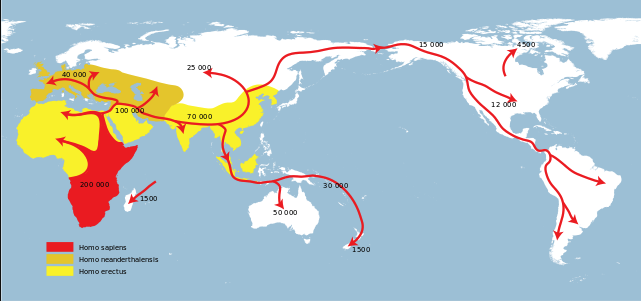Homo sapiens evolved from their early hominid predecessors between 200,000 and 300,000 years ago and developed a capacity for language about 50,000 years ago.

- Homo sapiens, the first modern humans, evolved from their early hominid predecessors between 200,000 and 300,000 years ago. They developed a capacity for language about 50,000 years ago.
- The first modern humans began moving outside of Africa starting about 70,000-100,000 years ago.
- Humans are the only known species to have successfully populated, adapted to, and significantly altered a wide variety of land regions across the world, resulting in profound historical and environmental impacts.
Where do we begin?

Before we tell the stories that make up world history, it is useful to ask: where do we begin? Where did our human stories start?
Homo sapiens is part of a group called hominids, which were the earliest humanlike creatures. Based on archaeological and anthropological evidence, we think that hominids diverged from other primates somewhere between 2.5 and 4 million years ago in eastern and southern Africa. Though there was a degree of diversity among the hominid family, they all shared the trait of bipedalism, or the ability to walk upright on two legs. 1

Scientists have several theories about why early hominids evolved. One, the aridity hypothesis, suggests that early hominids were more suited to dry climates and evolved as the Africa’s dry savannah regions expanded.
According to the savannah hypothesis, early tree-dwelling hominids may have been pushed out of their homes as environmental changes caused the forest regions to shrink and the size of the savannah expand. These changes, according to the savannah hypothesis, may have caused them to adapt to living on the ground and walking upright instead of climbing. 2

Hominids continued to evolve and develop unique characteristics. Their brain capacities increased, and approximately 2.3 million years ago, a hominid known as Homo habilis began to make and use simple tools. By a million years ago, some hominid species, particularly Homo erectus, began to migrate out of Africa and into Eurasia, where they began to make other advances like controlling fire. 3
Though there were once many kinds of hominids, only one remains: Homo sapiens. Extinction is a normal part of evolution, and scientists continue to theorize why other hominid species didn’t survive. We do have some clues as to why some species were less successful at surviving than others, such as an inability to cope with competition for food, changes in climate, and volcanic eruptions. 4
Migration and the Peopling of the Earth
How and why?
Between 70,000 and 100,000 years ago, Homo sapiens began migrating from the African continent and populating parts of Europe and Asia. They reached the Australian continent in canoes sometime between 35,000 and 65,000 years ago.
Scientists studying land masses and climate know that the Pleistocene Ice Age created a land bridge that connected Asia and North America (Alaska) over 13,000 years ago. A widely accepted migration theory is that people crossed this land bridge and eventually migrated into North and South America. 6
How were our ancestors able to achieve this feat, and why did they make the decision to leave their homes? The development of language around 50,000 years ago allowed people to make plans, solve problems, and organize effectively. We can’t be sure of the exact reasons humans first migrated off of the African continent, but it was likely correlated with a depletion of resources (like food) in their regions and competition for those resources. Once humans were able to communicate these concerns and make plans, they could assess together whether the pressures in their current home outweighed the risk of leaving to find a new one. 5
Adaptation and effects on nature
When humans migrated from Africa to colder climates, they made clothing out of animal skins and constructed fires to keep themselves warm; often, they burned fires continuously through the winter. Sophisticated weapons, such as spears and bows and arrows, allowed them to kill large mammals efficiently. Along with changing climates, these hunting methods contributed to the extinction of giant land mammals such as mammoths, giant kangaroos, and mastodons. Fewer giant mammals, in turn, limited hunters’ available prey.
In addition to hunting animals and killing them out of self-defense, humans began to use the earth’s resources in new ways when they constructed semi-permanent settlements. Humans started shifting from nomadic lifestyles to fixed homes, using the natural resources there. Semi-permanent settlements would be the building-blocks of established communities and the development of agricultural practices.
They hunt eachother, and still do. Since Chimpanzees are technically hominids, and have been targeted by human hunters, hominids still hunt each other. However, I assume that you’re talking about prehistoric hominids, and the answer to that is that we don’t know.
There is very limited information on interaction between hominid species. Most hominids have a diet largely based on vegetables and scavenging. Active hunting is rare, and hunting other predators is extremely rare. So any conflict between hominids would be rare. Similar, it would be difficult for different hominid species to communicate with eachother, so it’s unlikely that they would have cooperated with us. Humans today don’t trade with chimpanzees or gorillas largely because of this extremely steep communication barrier.
However, we do know that Neanderthals and Homo Sapiens interacted. This is evidenced by the presence of Neanderthal DNA in the genome of people of European, Middle Eastern, and Asian descent. That indicates that there was at least some inbreeding between neanderthals and homo sapiens, which suggests intimate relationships between the two groups. Beyond that, the nature of neanderthal-homo sapiens interaction is still unclear.